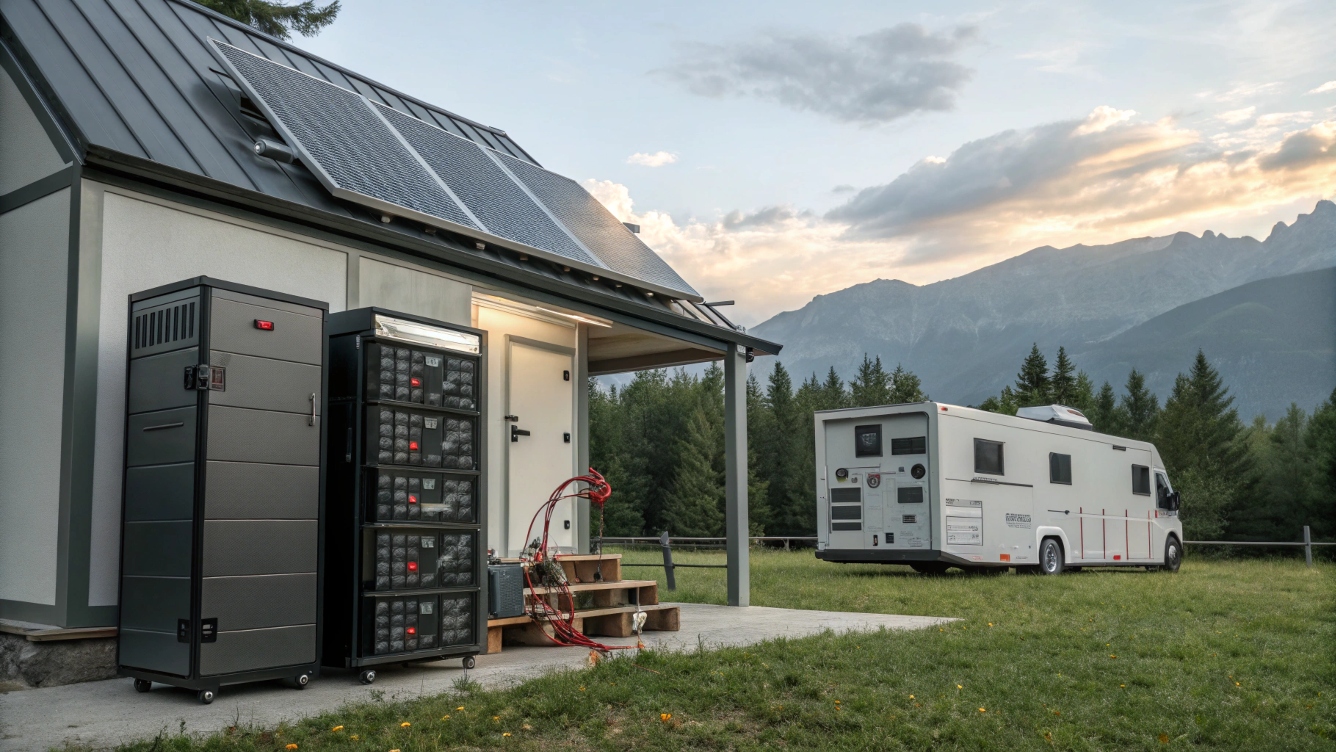Combien de temps une batterie au lithium 200Ah exécutera un onduleur de 1000W?
Comprendre les bases: Capacité de la batterie et efficacité de l'onduleur
Combien de temps une batterie au lithium 200Ah exécutera un onduleur de 1000W?
Une batterie au lithium 200AH associée à un onduleur de 1000W est une configuration courante pour les systèmes solaires hors réseau, VR, et puissance de sauvegarde d'urgence. Mais combien de temps durera-t-il? Décomposons les mathématiques.
Étape 1: Calculer le stockage total d'énergie
- 12V: 200Ah × 12v = 2,400Wh (wattheures).
- 24V: 200Ah × 24v = 4,800Wh.
Étape 2: Tenir compte de l'efficacité de l'onduleur
Les onduleurs perdent 10-15% Énergie pendant la conversion DC-AC. Pour une charge de 1 000 W:
Required Battery Power = 1,000W ÷ 0.85 (85% efficiency) ≈ 1,176W per hour.
Étape 3: Facteur en profondeur (Ministère de la Défense)
Batteries au lithium (LiFePO4) peut se décharger en toute sécurité à 80-90% Ministère de la Défense. Pour la longévité, supposer 80%:
Usable Energy = 2,400Wh × 0.8 = 1,920Wh.
Formule d'exécution:
Runtime (hours) = Usable Energy ÷ Load Power.
Exemple: 1,920WH ÷ 1 176W ≈ 1.63 heures.
Scénarios du monde réel: Ce qui impacte l'exécution?
1. Fluctuations de chargement
Un onduleur de 1 000 W fonctionne rarement à pleine capacité en continu. Si votre charge moyenne est de 600 W:
Runtime = 1,920Wh ÷ (600W ÷ 0.85) ≈ 2.72 hours.
2. Effets de la température
- Temps froid: En dessous de 0 ° C (32° F), Les batteries au lithium perdent 10-20% capacité:citer[7].
- Chaleur: Au-dessus de 40 ° C (104° F), L'efficacité de l'onduleur tombe en 5-10%.
3. Santé de la batterie
Les batteries plus anciennes se dégradent: Une batterie de 200Ah de 3 ans ne peut offrir que 1 700Wh.
Pour la pointe: Associez votre batterie au lithium ion pour l'énergie solaire avec un moniteur de batterie intelligent pour suivre la capacité et la santé en temps réel.
Prolonger l'exécution avec Systèmes de batterie empilables
Une batterie de 200AH peut ne pas suffire pour l'énergie toute la journée, mais Systèmes de batterie empilables Laissez-vous faire évoluer le stockage de manière transparente. Par exemple:
- 2 Batteries: 400Ah (4,800Wh) → Runtime ≈ 3.26 heures à 1 000w.
- 4 Batteries: 800Ah (9,600Wh) → Runtime ≈ 6.8 heures.
Avantages de l'empilement:
- Conception modulaire: Ajouter des unités à mesure que les besoins énergétiques augmentent.
- Équilibrage de charge: Distribuez le tirage de puissance pour réduire la tension sur les batteries individuelles.
- Compatibilité hybride: Mélanger avec des panneaux solaires pour une charge continue.
Explorez notre Kits de batterie modulaire pour des configurations personnalisables.
Optimisation de votre système pour une efficacité maximale
1. Utiliser des onduleurs à haute efficacité
Onduleurs à ondes sinusoïdales pures (90-95% efficacité) Surperformant les modèles d'ondes sinusoïdales modifiées (75-85%). Notre Onduleur hybride solaire GYCX réduit les pertes de 15%, Extension de l'exécution.
2. Associer avec des panneaux solaires
Un réseau solaire de 600W peut compenser les charges diurnes:
- Rendement solaire quotidien: 600W × 5 heures du soleil = 3 000 wh.
- Drainage net: 1,000W chargement - 3 000 wha solaire = Surplus d'énergie, Élimination de la décharge de la batterie.
3. Gestion de l'énergie intelligente
- Charges prioritaires: Courir des éléments essentiels (réfrigérateur, lumières) Pendant les basses heures solaires.
- Utilisation planifiée: Retarder les tâches à forte puissance (Par exemple, micro-ondes) pour des périodes ensoleillées.
Étude de cas: Cabine hors réseau avec Batteries au lithium prête pour le solaire
Une famille du Colorado en utilisant notre 24V 200AH Batterie de montage mural réalisé:
- Temps d'exécution: 1.8 heures à 1 000w (80% Ministère de la Défense).
- Intégration solaire: Des panneaux de 800W ajoutés, Découpe la dépendance de la grille par 70%.
- Économies de coûts: Réduction des coûts de carburant du générateur de 120 $ / mois.
Analyse comparative: Lithium vs. Plomb-acide
| Métrique | Lithium (LiFePO4) | Plomb-acide |
|---|---|---|
| Capacité utilisable | 80-90% | 50% |
| Cycle de vie | 3,000–6 000 cycles | 300–500 cycles |
| Lester (200Ah) | 19.5kg (43 lbs) | 55kg (121 lbs) |
| Perte d'efficacité | 5-10% | 15-20% |
Données provenant de repères de l'industrie et de Wikipedia: Batterie au lithium fer phosphate.
FAQ: Répondre aux questions critiques
Q: Puis-je exécuter un micro-ondes de 1 000 W?
UN: Oui, mais seulement pendant environ 1,6 heures sur une seule batterie 200h. Pour une utilisation plus longue, ajouter piles empilables ou panneaux solaires.
Q: Comment recharger la batterie en utilisant l'onduleur?
UN: Connectez un contrôleur de charge solaire à des charges d'alimentation et de recharge simultanément la batterie.
Q: Une batterie 200h est-elle sûre pour l'utilisation de RV?
UN: Absolument! Notre batteries au lithium prête pour le solaire Inclure des BM intégrés pour une surchauffe et une protection excessive.
À l'épreuve de l'avenir avec Systèmes hybrides solaires-lithium
Pour 24/7 pouvoir, combiner:
- 200Batterie Ah au lithium: Stockage de base.
- 1,000Onduleur W: Gère les charges AC.
- 600W Bread Solar: Recharge la batterie quotidiennement.
- Contrôleur MPPT: Maximise la récolte solaire.
Cette configuration réduit l'anxiété d'exécution et réduit la dépendance de la grille par 80%:citer[5]:citer[9].
Conclusion: Énergie plus intelligente, Temps d'exécution plus long

Une batterie au lithium 200Ah alimente un onduleur de 1 000 W pour 1.6–2,7 heures, Selon la charge et les conditions. Pour le temps d'exécution prolongé, adopter Systèmes de batterie empilables et l'intégration solaire. Chez GYCX Solaire, Nous nous spécialisons dans des solutions modulaires qui se développent avec vos besoins énergétiques, que vous puissiez une cabine, VR, ou système de sauvegarde d'urgence.
Étapes suivantes:
- Calculez vos besoins exacts avec notre outil de dimensionnement solaire.
- Explorez les batteries au lithium prêtes pour les solaires pour les configurations sans tracas.
- Regardez notre guide d'efficacité pour maîtriser la gestion de l'énergie.
Références
- Efficacité de la batterie au lithium: Wikipedia: Batterie au lithium fer phosphate.
- Données de performances de l'onduleur: Rapports de l'industrie de POWMR et Delong Tech.


